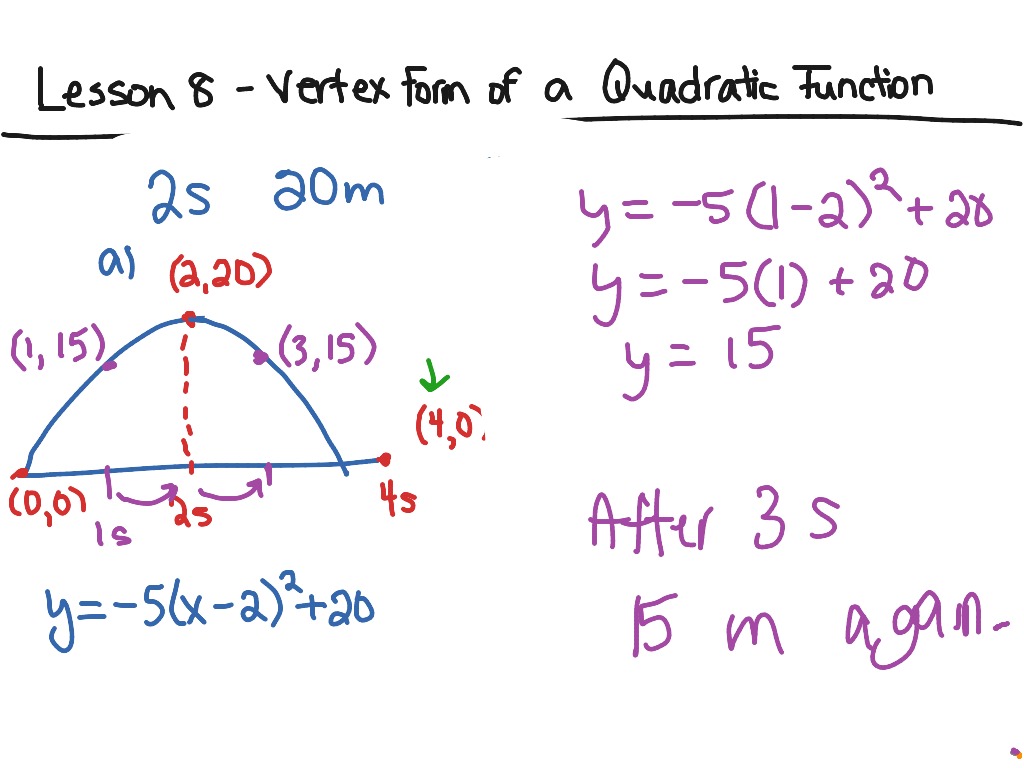

If, on the other hand, you suppose that “ a” is negative, the exact same reasoning holds, except that you’re always taking k and subtracting the squared part from it, so the highest value y can achieve is y = k at x = h. And the lowest point on a positive quadratic is of course the vertex. So the lowest value that y can have, y = k, will only happen if x = h. When does y equal only k? When x – h, the squared part, is zero in other words, when x = h. That is, the smallest value y can be is just k otherwise y will equal k plus something positive. Suppose that “ a” is positive, so a( x – h) 2 is zero or positive, and, whatever x-value you choose, you’re always taking k and adding a( x – h) 2 to it. In the vertex form of the quadratic, the fact that ( h, k) is the vertex makes sense if you think about it for a minute, and it’s because the quantity “ x – h” is squared, so its value is always zero or greater being squared, it can never be negative. (Yes, it’s a silly picture to have in your head, but it makes it very easy to remember how the leading coefficient works.) Think of it this way: A positive “ a” draws a smiley, and a negative “ a” draws a frowny. The sign on “ a” tells you whether the quadratic opens up or opens down. The “ a” in the vertex form is the same “ a” as in y = ax 2 + bx + c (that is, both a‘s have exactly the same value). The vertex form of a quadratic is given by y = a( x – h) 2 + k, where ( h, k) is the vertex. Read Also: Antiderivative Calculator – A Brief Introduction Vertex Form Of A Quadratic So, the vertex of the parabola is at (-2, -24). Substituting in the original equation to get the y-coordinate: Question: Find the vertex of the parabola: y = 3 x 2 + 12 x − 12 You can then plot the data points to graph the parabola. Graphing the parabola in vertex form requires the use of the symmetric properties of the function by first choosing a left side value and finding the y variable. The quadratic equation is now in vertex form. The value of h is equal to half the coefficient of the x term. Standard Form To Vertex Form Factor Coefficientįinally, convert the terms inside parentheses to a squared unit of the form (x – h)^2. The vertex form of a quadratic equation is y = m(x-h)^2 + k with m representing the slope of the line and h and k as any point on the line. However, if you need to graph a quadratic function, or parabola, the process is streamlined when the equation is in vertex form. It is easier to solve a quadratic equation when it is in standard form because you compute the solution with a, b, and c. The standard form of a quadratic equation is y = ax^2 + bx + c, where a, b, and c are coefficiencts and y and x are variables. If |a| 1, the graph of the graph becomes narrower(The effect is the opposite of |a| If a is negative, then the graph opens downwards like an upside down “U”.If a is positive then the parabola opens upwards like a regular “U”.(h,k) is the vertex as you can see in the picture below.Observe that when the graph opens up, the range of the corresponding quadratic function is k, ∞, while if it opens down, the range is − ∞, k. Use the sliders to change the vertex h, k and observe how your changes affect the graph of the parabola.

Complete the square by addition and subtracting the magic number - the square of half the coefficient of x. Factor the leading coefficient out of the first two terms.Ģ. To convert from the standard form y = ax 2 + bx + c to vertex form, you must complete the square.ġ. For a parabola whose equation is given in standard form. The vertex form of a parabola is usually not provided. The vertex of a parabola is the point at the intersection of the parabola and its line of symmetry. If a > 0 (positive) the parabola opens up, and if a < 0 (negative) the parabola opens down. The variable a has the same value and function as the variable in the standard form. The vertex form of a parabola is y = a x − h 2 + k where h, k is the vertex. The vertex of a parabola is the point at the intersection of the parabola and its line of symmetry.įor a parabola whose equation is given in standard form y = a x 2 + b x + c, the vertex will be the minimum (lowest point) of the graph if a > 0 and the maximum (highest point) of the graph if a < 0.


 0 kommentar(er)
0 kommentar(er)
